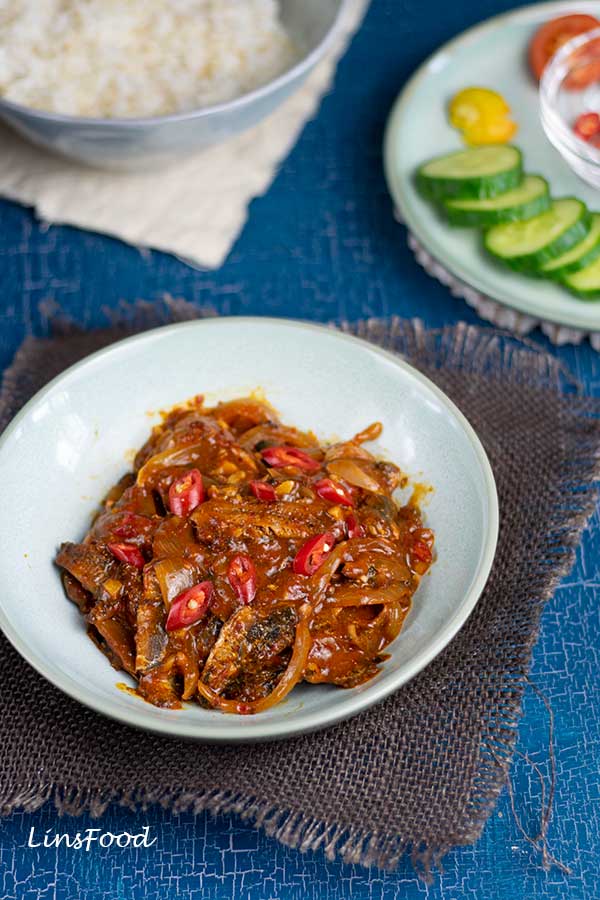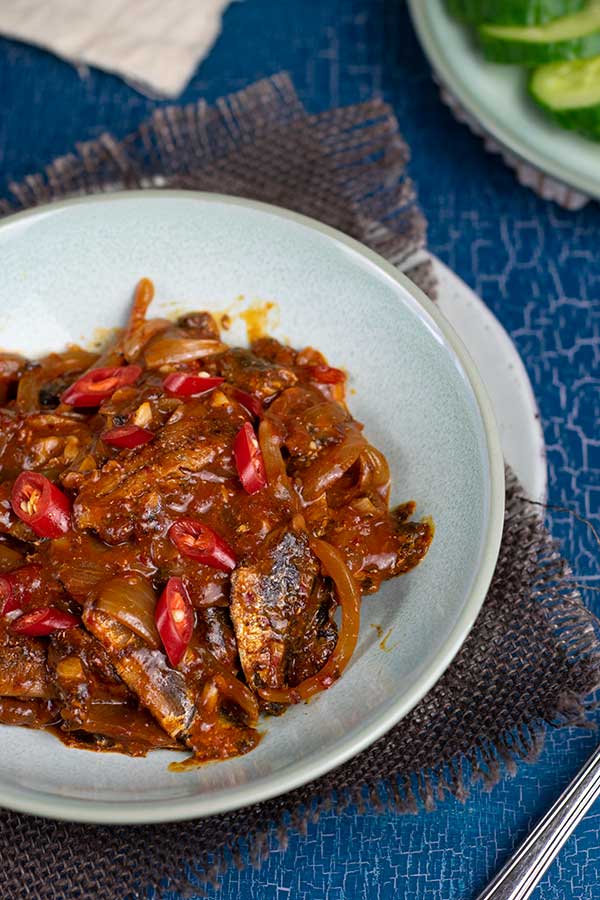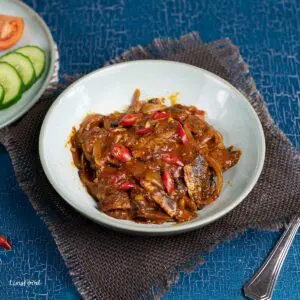Sambal sardin is one of my favourite ways to serve sardines at home. It’s a rustic, old fashioned recipe that’s quick, easy and ticks the spicy box!
Estimated reading time: 5 minutes

What is Sambal Sardin?
Let’s take a look at the name, as usual.
- sambal = there is no direct translation for this Malay/Indonesian word. It generally refers to something spicy. And that can be a condiment or a side dish. Lots of sambals on this site and LinsFood.com.
- sardin = well, that’s easy, right? It’s the Malay spelling for sardines.
So sambal sardin = sardine sambal.
It’s a spicy side dish with a thick sauce, and is a very popular home cooked side dish in Singapore and Malaysia, using pantry ingredients. You can make it as hot or as mild as you like, this is just a matter of taste.
Essentially, we’re taking that canned fish to the next level.
The Recipe
It’s a very easy recipe to make at home, with the simplest of ingredients. I’ll give you an optional step of lightly frying the sardines at the start, the way my mum used to make it. My grandma would just cook the sardines as they are.
This is what we’ll be doing to make our sambal sardin:
- Prepare the tamarind (if not using shop bought paste).
- Split the sardines and remove the bones. Pour the tomato sauce into a separate bowl.
- Prepare the onions, garlic and chillies.
- Optional step: heat the oil and fry the sardines for about 90 seconds each side. This is a rather delicate exercise, as those canned sardines are pretty fragile. But frying the sardines adds texture and flavour.
- Fry the aromatics.
- Add the chilli paste, tamarind and reserved tomato sauce.
- Tip the sardines back in, heat through for a minute, then top with lime juice. Serve up.
That’s it. Easy, right?

Sambal Sardin Ingredients
Not a whole lot to think about here, so I’ll just mention the sardines and chilli paste (cili boh) that we’ll be using to cook up our sardin sambal.
Sardines
We are using canned sardines in tomato sauce. The sauce in the can will make up part of the final sambal sauce. The larger the sardines, the easier it will be to handle them, which is especially important if you plan to fry them first.
But as you’ll see in the video, I’m using small ones, as they are the ones I can get easily.
Can’t get sardine in tomato sauce? Use the ones in oil. Drain them, then add 1 Tbsp tomato paste with 60 ml (1/4 cup) water.
Cili Boh
Cili boh is simply red chilli paste that’s sold everywhere in Singapore and Malaysia. It’s what we use in practically everything that calls for chilli paste as one of the ingredients.
I have an old recipe on LinsFood for that. But that one is flavoured with aromatics, tamarind and sugar. Look out for our cili boh recipe on this site in the next week or two.
In the meantime, any shop bought red chilli paste or ground up red chillies will work. Or, you could use the sambal balado recipe on this site. Or the sambal oelek recipe on LinsFood.


Variations
You could bulk up our sadin sambal slightly, if you fancy. One of the things I love adding to it is fresh tomatoes. I add them right at the end, with the sardines, so they’re hardly cooked.
My mum used to add fried potatoes to her sambal sardin. Now this is something I just love but I don’t do it too often, because I’m not too keen on all that oil.
Essentially, all you do, is slice your potatoes thinly, you don’t even have to peel them. Fry them in some oil to crisp up until they’re fully cooked through. Then just add them to the dish, along with the sardines, right at the end.
How to Serve Sambal Sardin?
Treat it like a side dish. So you’d serve it with rice. Plain, boiled (steamed) is best but nasi goreng (fried rice) will work too. It’s one of those rustic, kampung recipes that really doesn’t need any frills. I usually just have it with some rice and a salad of cucumbers and tomatoes. That’s it, for a very satisfying meal that reminds me of home.
- kampung = village
- lemak (below) = creamy; in culinary terms, it implies that something’s been cooked in coconut milk
If you wanted to serve it as part of a bigger meal, our sambal sardin goes so well with lemak dishes, see below.
Sambal sardine also makes great sandwiches. In fact, that’s probably my favourite way with them. Buttered bread, sambal sardin, lettuce, cucumbers and tomatoes – total yum!


There you have it. Super easy, rustic recipe that I still make very regularly. Let’s get cooking!
If you like the recipe, drop me a comment to let me know. And if you’re feeling like a star, don’t forget that 5-star rating! 😉Thank you!
If you make the recipe, share it on any platform and tag me @azlinbloor, and hashtag it #linsfood
Lin xx

Sambal Sardin Recipe (Spicy Sardines)
Equipment
- 1 small bowl
- 1 frying pan with lid
- 1 spatula
- 1 large plate
- 1 knife
- 1 chopping board
- 1 serving dish
Ingredients
- 2 Tbsp tamarind pulp or 2 Tbsp shop bought paste
- 125 ml hot water (to soak tamarind)
- 300 g canned sardines in tomato sauce a little more or less, doesn't matter
- 1 medium onion about 150 g/5 oz pre peeled weight
- 2 medium cloves garlic
- 2 fresh red chillies or 5 birds eye
- 2 Tbsp vegetable oil
- 2 Tbsp red chilli paste (like cili boh or sambal oelek) see article
- 1 Tbsp fresh lime juice any lime will do
- freshly ground black pepper
Instructions
Tamarind Juice
- Place your tamarind pulp in a bowl and pour the hot water over it. Leave to soak while you get the aromatics and sardines ready.
- When the aromatics and sardines are done, mash the pulp with your fingers and leave aside until needed.If using shop bought paste, move on to the next step.
Prep Work
- Peel, halve, then slice the onion thinly.Peel and finely chop the garlic.Slice the chillies thinly.
- Sardines. Separate the sardine fillets, removing the bones and any visible guts.Be gentle with the sardines as they are fragile. Don't worry about the odd one breaking.
- Keep the sauce aside, in a different bowl.
Let's Get Cooking
- Optional Step: frying the sardines.Heat the oil in a large frying pan over medium-high heat and fry the sardine fillets in a single layer for 90 seconds. Be gentle, as you spread them out.As soon as you've spread the fillets out, cover with a lid as it will splutter like crazy.
- After 90 seconds, turn the heat off to reduce the spluttering. If you are concerned about hot oil splatter on your skin, count to 10 before lifting the lid, to allow the oil to settle down.Turn the sardine fillets over, to brown the other side. Turn the heat back on to medium-high, cover, and fry for 90 seconds again.
- Turn the heat off, and remove the browned fillets onto a plate. I'm using the same one as before.
- Turn the heat on to medium and fry the onion slices for 2 minutes, stirring and scraping the crispy bits at the bottom of the pan.I don't bother adding anymore oil, as there's just enough left in the pan.
- Add the garlic and chilli paste and fry for 1 minute.
- Stir the soaking tamarind with your fingers and pouring the juice into the pan, using your fingers as a strainer to stop the seeds and any fibre and shell from being added.If you're not comfortable with this, use a large mesh strainer to strain the tamarind juice straight into the pan.
- Remember the tomato sauce we reserved earlier? Add that to the pan too. Stir well and bring to a simmer. Cook on the lowest heat for 2 minutes, uncovered.
- Tip the sardines back into the pan and very gently mix everything together. Best way: slide your spatula along the surface of the pan, lift the sardines, and gently tip them back into the sauce. Watch me do this in the video at 2:25.Heat through for 1 minute.
- Check seasoning. It shouldn't need any salt, but add some if it's not salty enough for you.Finish off with a squeeze of lime juice and the chopped chillies.
